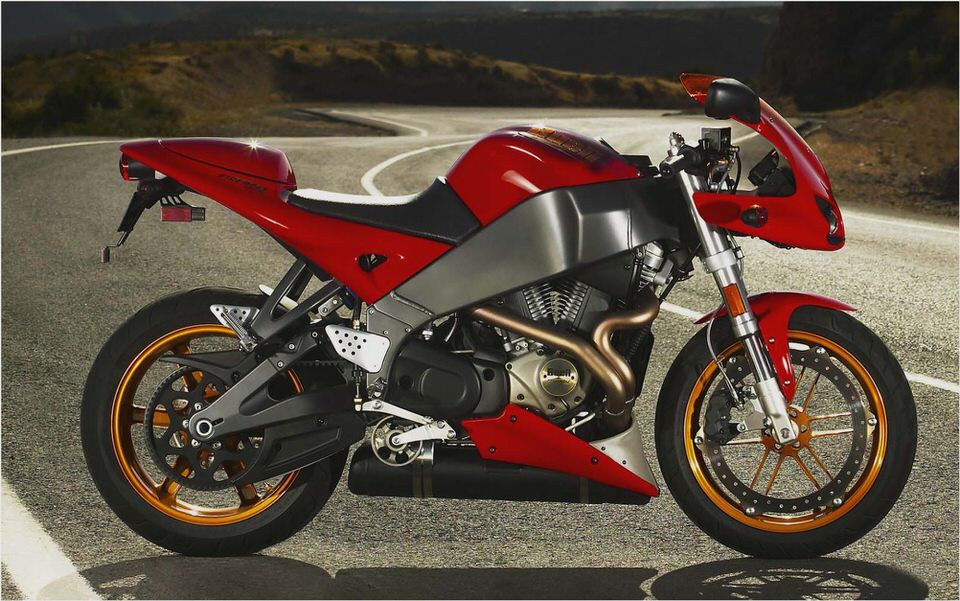
2004 Buell XB12R Firebolt
The new 1200cc XB12R is Buell’s best bike yet, offering big torque, trick components and the exclusivity of a semi-exotic.
The XB Series Goes Whole Hog
I wasn’t sure what to think of Amanda when I first met her. She had a rebel attitude that was intriguing, but rationality wasn’t her thing and I didn’t consider her my type. She was different than other girls and, at first, I didn’t respect her much.
Things she did used to annoy me but I eventually warmed to her unique presence.
And so it went with my experience on the XB12R Firebolt, a larger-displacement version of the radical XB9 series from Buell that is powered by hot-rodded Harley-Davidson Sportster engines. While the XB9s get motivation from a 984cc, 45-degree, air-cooled V-Twin, the new-for-2004 XB12s feature a 1203cc stroked version.
The R that ends the XB series’ nomenclature denotes the racier version with a quarter fairing, lower clip-on bars and higher footpegs. The S version of the XBs is built in the streetfighter mold, with a tubular handlebar that sits higher and just a small flyscreen above the headlight. All four of the XBs (including the XB9S we pitted against the new Ducati Monster 1000S) have the same innovations such as the large aluminum frame rails serving as the fuel tank and the engine oil being carried in the alloy swingarm.
My relationship with Buells began several years ago when testing the 1999 M2 Cyclone with the same 1203cc displacement as the new Firebolt. I was rooting for the concept of an American-made sportbike, and after spending several hours with Erik Buell, a former pro road racer, I fully bought in to his innovative way of thinking. But, alas, an exhaust header stud pulled out of the Cyclone’s rear cylinder near the end of 1600 miles of abuse, souring me on the idea of a Harley-powered sportbike.
Four years later, I wasn’t sure how I was going to get along with the new Buell. The company claims its reliability problems are a thing of the past thanks to intensive RD efforts.
Firing up the XB12R for the first time was a reminder of the old M2, as Buell’s Uniplanar rubber engine mounts allow the Buell-modified mill to shake around disconcertingly like a paint bucket at the Home Depot, turn signals dancing like a recovering crack addict. A rider’s vision can literally blur while waiting at a traffic light, and the trembling engine moves around so much that onlookers occasionally are frightened the big lump might jump out of the bike. It’s like having a Mopar Hemi V-8 with two pistons missing residing between your legs, manly!
But the motor’s oscillations appear more violent than they feel, thanks to Buell’s Uniplanar engine-mounting system that absorbs most of the quaking below. Once underway, the engine magically smoothes out and becomes almost entirely unobtrusive.
Even with the horizon tilted toward vertical, the XB12R has plenty of cornering clearance.
But the motor’s oscillations appear more violent than they feel, thanks to Buell’s Uniplanar engine-mounting system that absorbs most of the quaking below. Once underway, the engine magically smoothes out and becomes almost entirely unobtrusive.
The XB’s powertrain is a mix of the superb and the mediocre. All 2004 XBs (including the 9s) receive lighter pistons, valves and one-piece connecting rods. The throttle body on the XB12’s fuel injection system has a 3mm-larger diameter than the XB9’s 45mm size, and it works almost flawlessly. Cold starts are automatically compensated by the ECU, making the beginning of a ride a one-button affair. But the FI is not perfect.
The engine occasionally coughs through the intake when cracking the throttle off-idle, especially when hot, and this hiccup once caused the bike to stall when trying to get underway from a stop light.
When it doesn’t cough, as is normally the case, the XB12 can serve up a very quick sprint from a stop. Thanks to the terrifically modulatable clutch, a keen rider can carry the front wheel from a dead stop across an intersection, if so inclined. However, when it comes time to bang up another gear, the XB’s Sportster-based transmission becomes an obvious wart.
The 1-2 shift is crap and the gearbox clunks noisily when upchanging; clutchless shifts sound like a Peterbilt. In addition, I found a false neutral between gears 3 and 4. Clutch effort, with a stronger clutch spring on the 12, isn’t too high, and more leisurely shifts are usually smooth.
The common opinion is the Harley-sourced air-cooled V-Twin isn’t a sportbike motor. Don’t listen – this thing rocks.
Working in the XB12’s favor is that shifts are nearly optional due to the two-valve-per-cylinder motor’s bountiful powerband. This isn’t just an engine but a powerplant . Saying the XB12 is torquey is understating its available grunt down low, akin to calling Pamela Anderson pretty.
Torque comes from the Buell’s big cylinders, but the linearity of the powerband is due to a couple of tuning tricks. The beautifully shaped, complex bends of the head pipes are up 0.25-inch in diameter from the XB9 to 1.75 inches for improved flow from the 219cc larger mill. The under-engine muffler is also different than its little brothers’, as it employs a computer-controlled valve called Buell Interactive Exhaust.
The valve opens at low rpm for the best flow, then closes in the midrange for optimum torque before opening again at high rpm, responding via throttle position and engine speed. The change in tone was plainly audible during the dyno runs we made with our friends at White Brothers Racing.
Combine all of the above and what you have is a truly wonderful street engine. Right off idle there is more than 55 lb.-ft. of torque for immediate low-rpm lunge. For reference, something like the Honda CBR600RR produces its maximum torque of 45 lb.-ft. all the way up at 11,000 rpm.
The XB12’s torque hovers above 65 lb.-ft. from just past 2500 rpm all the way until the rev limiter kicks in at 6800 rpm, peaking at a barrel-chested 74 lb.-ft.
With the new engine, we offer power that will satisfy the most demanding sport rider, explains Erik Buell, founder, chairman and chief technical officer of the company that bears his name. Not just peak horsepower, but the kind of ground-pounding, mid-range torque you can use to accelerate instantly in any situation.
For the record, the XB12 pumps out 92 hp at 6700 rpm on a Dynojet rear-wheel dyno, a significant 20 ponies up on the XB9S Lightning we recently tested on a similar dyno. More impressive than the peak number is the pure linear increase in power through the rev range. This, as E-Buell suggests, makes the XB12 engine nearly ideal for street usage.
Check out that linear hp curve and bodacious torque output that lets a Firebolt rider put down power regardless of the chosen gear.
The new Buell and I weren’t getting along well at first. I cursed inside my helmet about the dearth of top-end power when wringing it out, and the clunky, Massey Fergusson gearbox was annoying as I snapped off upshifts and downshifts like I was riding a 600.
It took me awhile, but I finally got into the Buell swing of things. I was riding home one evening, relaxed but tuned in to the machine. I was in no hurry, but I had a heightened sensory sensitivity to everything around me. (No, I was not smoking anything.) Rather than try to hurry things, I slowed them down, letting the grunty V-Twin launch me from stops with authority while keeping my shifts below 3200 rpm.
It turned out to be a pleasant kind of excitement: Not boring in any way, but not manic, either, as I let the oodles of torque whisk me along my way effortlessly.
I took the same philosophy to one of my favorite SoCal canyon roads. Latigo Canyon is a tight and twisting snake that winds its way from Malibu’s coastal area into the Santa Monica Mountains. It boasts something like 212 corners in less than 10 miles, so you can imagine that there are plenty of tight turns and not a lot of straightaways.
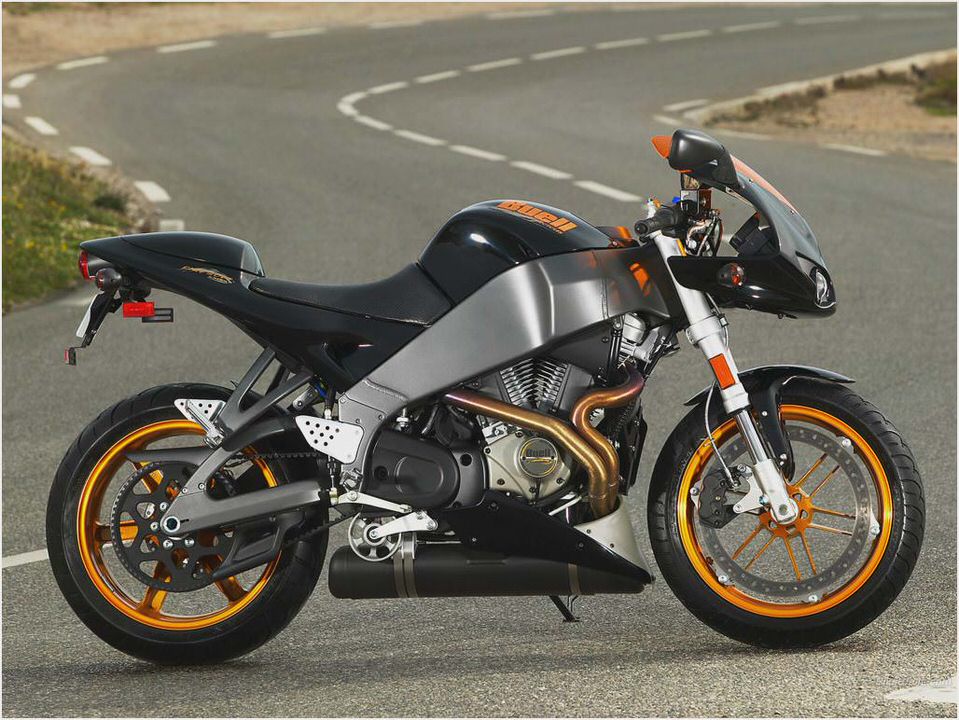
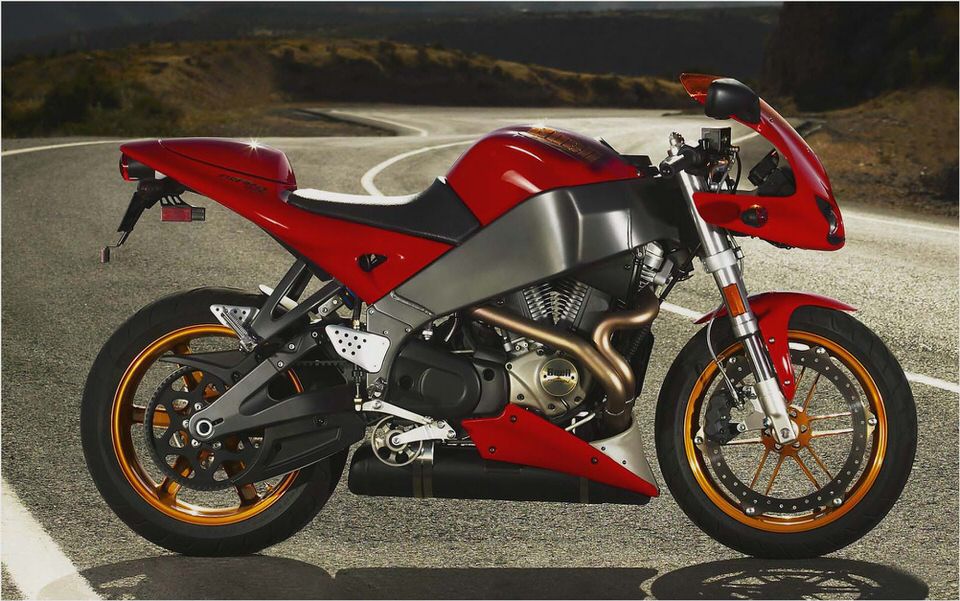
It was here that the XB12R helped me achieve something I didn’t think was possible: I rode the entire road in third gear!
While using only one gear isn’t the quickest way to get through Latigo, just the fact that it’s possible to do it and make good time is impressive, as speeds varied from 25-80 mph. The beastly motor pulls cleanly from as low as 1800 rpm, and it pounds out the torque like a big block V-8 as the revs rise.
The 12’s tons of torque results in less shifting and smoother application of power, while the new and stronger belt drive system results in virtually zero driveline lash like you get with a chain- or shaft-drive. In this respect, and with a smooth throttle uptake from the fuel injection, this is the smoothest drivetrain I’ve experienced on a sportbike, with not a hint of the abruptness many other injected bikes have when re-applying the throttle coming out of corners.
With a scant 52 inches between its axles and loads of torque, the Firebolt makes for fun Buelligan antics.
Next I moved on to a different venue, Orange County’s famed Ortega Highway, where the road generally curves at a more relaxed pace than the frantic Latigo. This time I took a passenger along. The zero-lash driveline and seamless fuel injection results in less helmet bashing, making the XB12 a great two-up motor.
In these wider corners I could stay mostly in fourth gear for a casual yet brisk ride.
For those who are incessantly whining about not evaluating the passenger accommodations, this is your lucky day. Buell has lowered the passenger pegs two inches lower than the 2003 XBs, and so it now offers decent legroom for your pillion. The rear seat, however, feels harder and harder as the ride goes on, and the toes of your back-seat mate will go numb after a long freeway stint.
A plastic body-colored seat cowl slips over the rear seat when riding solo.
I’m quite lucky to test brand new motorcycles all year round, but, like most of us, I’m not fortunate enough to live on a canyon road. That means a fair bit of superslab riding before our sportbikes can thrive in the environment for which they were created. The Firebolt’s close-coupled riding position didn’t force too much pressure on wrists, and my 5’8 body wasn’t excessively scruntched up.
The legs of taller riders might get cramped from the high pegs that offer plenty of ground clearance.
The 43mm inverted Showa fork proved to be quite plush, offering a surprisingly good freeway ride considering the bike’s ultra-stubby 52.0-inch wheelbase. The Showa shock’s compression damping was set a half-turn out from maximum when we received the bike, and changing it to three turns out improved the ride quality significantly; rear rebound was changed from ¾ out to 1.25 out from maximum. Damping adjustments at both ends were highly responsive to twiddling.
Mass centralization is apparent in this photo, as you can see the heavy engine, fuel, frame, muffler and transmission all stacked together in the middle of the bike.
At 80 mph, the tall engine is spinning at just 3800 rpm thanks to a taller primary drive ratio than fitted to the XB9s. At that speed, it’s a smooth cruise, with ample grunt on tap for quick blitzes past slower cars without the need to downshift. Speeds above 80 mph have the engine in an rpm where vibration begins to get intrusive, eventually numbing a rider’s hands.
Despite the vibration-isolating engine mounts, vibration sneaks through the solid-mounted clip-on handlebars and the firm seat; a skinny butt will get sore after more than an hour in the saddle. Mirrors, on longer struts in 2004, are decently placed, but there’s several rev ranges that blur the images quite badly.
Getting into a corner is always preceded by a straightaway, and it’s at the end of the latter when you want the best binders to get you slowed down. Scrubbing off speed on the XB series is the responsibility of the trick-looking perimeter-style front brake.
Here’s the theory: A single 375mm rotor with 6-piston caliper is used because it reduces unsprung weight compared to a twin-disc setup; and the perimeter mounting system isolates the front wheel from most of the braking forces, allowing a front wheel with thinner spokes, further reducing unsprung weight. In practice, it proved to be easy to modulate and has plenty of power for the street. The 240mm rear disc brake and single-piston caliper isn’t very strong, making it easy to modulate without locking the tire unexpectedly.
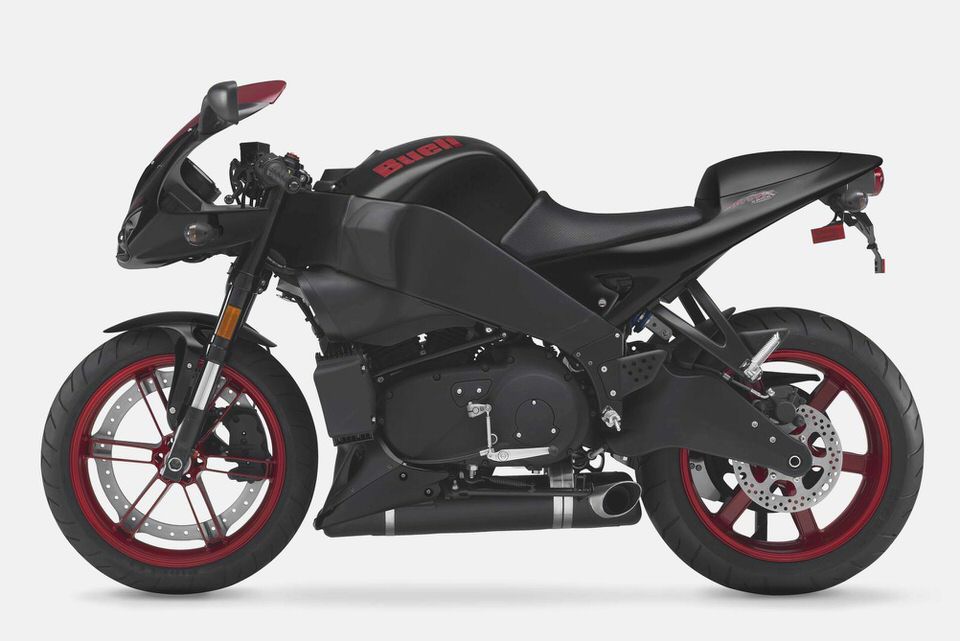
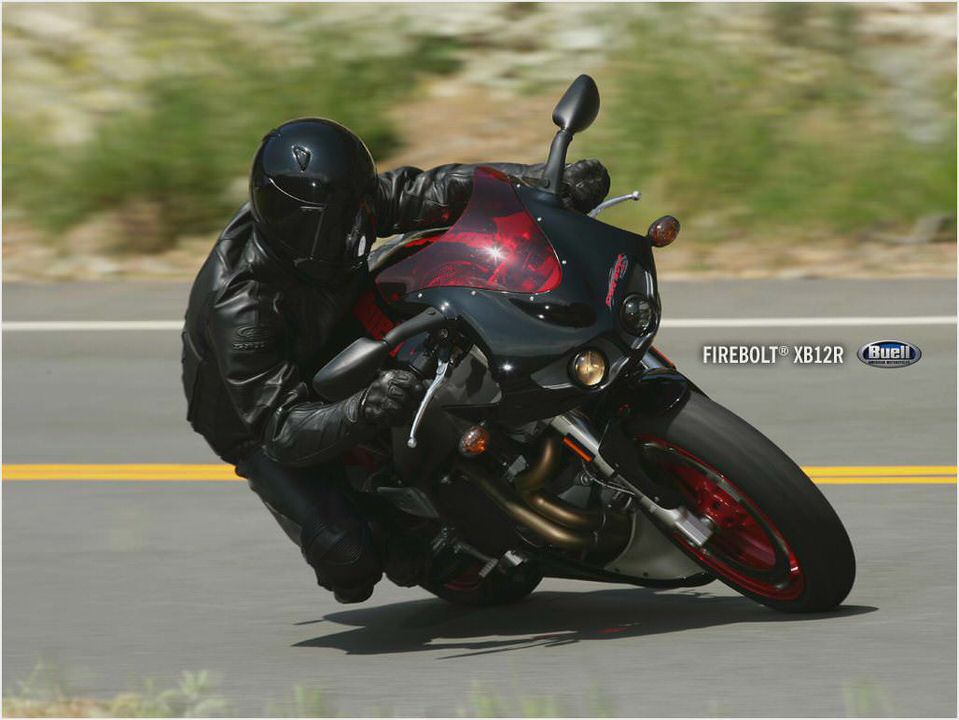
- Buell X1 – Buell
- 2008 Buell 1125R – Motorcyclist Magazine
- Buell 1125R Daytona Sportbike Racer: MD Ride Report …
- Opinions on Buell Firebolt XB12R – Speedzilla Motorcycle Message Forums
- Erik Buell Racing 1190RR Motorcycle Review with Specs and Pictures

